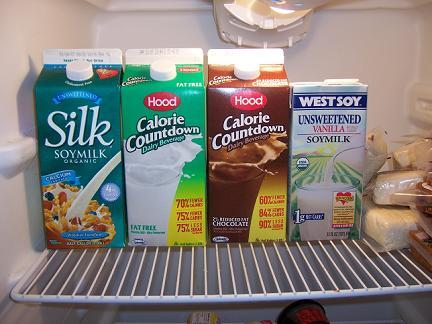
I’ve blogged before about the use of fiber in dieting, and I thought I’d give an update about how I’m currently using it.
Fiber is a kind of carbohydrate, but it’s a kind of carbohydrate that I’m actually friendly to.
Carbs, y’see, come in different kinds. On the one hand, there are simple, refined carbohydrates like those you find in table sugar or white flour that are absolutely horrendous for you. These are positively EVIL and are the cause of everything from obesity to diabetes to hardened arteries to who knows what. Bad, bad stuff. They are instantly digestible, cause huge insulin spikes, and humans cannot healthily have them in anything but small quantities.
Unfortunately, they are cheap to produce and have long shelf-lives, so the food industry is pushing them at us right and left.
Then there are "complex carbohydrates," which are harder for us to digest and that correspondingly have a lower impact on your blood sugar. These are found in things like whole grains, and they are much better (or at least less horrendous) for us. Some humans can healthily have these in large amounts. Others (like myself) cannot. It depends on your own particular metabolism.
Then there are really complex carbohydrates. In other words: fiber. Dietary fiber consists of the carbohydrates in our food that we either cannot digest or cannot digest very much. They are digestion-resistant (in humans) and so do not spike our blood sugar. They’re still carbohydrates, though, and so they get listed on nutrition labels (like the one pictured here) under the heading of "Total Carbohydrates."
This is why you hear low-carb dieters talking sometimes about "net carbs." Net carbs are those carbohydrates that have significant impact on your blood sugar. The way to determine them is to take Total Carbohydrates and subtract out Dietary Fiber. Since we can’t really digest that, it won’t mess up your blood sugar. In the example above, the product would have 10 grams of net carbohydrates (13g – 3g = 10g).
You can also subtract out certain other carbohydrates that don’t have a major impact on blood sugar, such as sugar alcohols (MORE INFO HERE.)
It’s important for low-carb dieters to understand how many net carbs they’re putting into their bodies, but fiber isn’t just a good thing on low-carb diets. It’s a good thing for everybody, even people who aren’t dieting.
Fiber not only helps fill you up so that you don’t eat more (good for dieters), it also can help lower your cholesterol, stabilize your blood sugar, stimulate your immune system, prevent certain types of cancer, and (of course) keep you regular.
In other words, IT’S JUST GOOD FOR YOU, OKAY!
The problem is, with the food industry pushing all those simple, refined carbohydrates at us, the average American doesn’t get anywhere near the amount of fiber he should have. An average adult should get at least 20-35 grams of fiber a day, and most of us just don’t.
Which is where fiber supplements come in.
There are different types of fiber, and they help with different things. Consequently, the best type of fiber supplement to take is a mixed fiber supplement–one that combines several different types of fiber. HERE’S THE ONE I USE.
This is a powder, so I mix it with water and then drink it down–fast, before it has a chance to gel up. It is also available in capsules, but I don’t normally use those because you have to take a bunch of capsules to equal the amount of fiber you get in one tablespoon, and that’s inconvenient. (It’s also cheaper to use the powder, and you don’t have to worry about whether all the capsules will dissolve; if some of them break before the others, they might gel up and keep the others from dissolving).
I do not recommend the use of compressed fiber tablets because you never know if they will dissolve or how much.
A while back I started drinking a glass of water with a couple of tablespoons of fiber in the morning and one again in the afternoon, but recently I changed my practice since I found that I would often forget to have my fiber on this plan.
What I do now is have a tablespoon of fiber each time I eat–either right before eating or right afterwards. By coupling the fiber with when I eat, I don’t forget.
There’s a benefit to taking fiber right before you eat in that it will help fill you up fast so that you eat less. That’s not as much of an issue for me, though, since I don’t generally eat three full meals, the size of which varies. I usually have six or so small snacks per day of 200-400 calories each, so I’m not tempted to overeat on particular occasions due to having gone without food for a longer period of time. Consequently, I often take the fiber after eating rather than before.
I also take extra fiber if I’m eating something that is a little higher in carbs or calories since it will help slow down the absorption of the carbs and reduce my blood sugar spike or reduce the absorption of the calories.
It can be hard, though, to always mix a glass of fiber, drink it, clean the glass, etc.–particularly during the workday, so recently I adopted another solution to this problem: Sticking a spoonful of fiber directly into my mouth and then washing it down with water (or, more likely, a diet coke, remembring that "coke" means any carbonated soft-drink; I don’t actually drink Diet Coke since it has caffeine and Aspartame in it).
The thing is, I can’t do that with the mixed fiber supplement recommended above. There’s something about the texture of that which requires it to be mixed with water and then drunk down. If you put it directly into your mouth it instantly clumps up and sticks to your mouth and the result is like trying to clean your mouth with your tongue if you’ve got peanut butter stuck all over it–only worse.
This effect does not happen, though, with all kinds of fiber, and so when I do the spoon-in-the-mouth trick I use powdered PSYLLIUM HUSKS.
Psyllium is an excellent fiber. It’s the one that is used in most fiber supplements (like Metamucil). If you’re going to take an unmixed supplement, psyllium is the one to take. It’s very beneficial, and it–at least at the level it is normally ground to–does not stick to your mouth like peanut butter on steroids.
Consequently, it’s very easy to just stick a spoonful in my mouth, sip a little coke, swallow it, and then drink the rest of the coke–no having to get glasses, fill them with water, stir them up, clean them afterwards, etc.
I still use the mixed fiber supplement as well, but when I’m "on the go" and don’t have time for that, I use the psyllium (which, incidentally, is cheaper yet).
So whether your on a low-carb diet, another diet, or just want good health, I’d strongly encourage you to consider using a fiber supplement.
There are, however, a few notes:
1) You must drink fluids when you take fiber. They recommend something like 10-12 oz of water per spoonful. This is because the fiber is going to absorb water as it bulks up inside you, and if you haven’t drunk fluid along with the fiber then it’s going to start absorbing fluid that you need for other purposes, like keeping your innards lubricated. If you find yourself getting unexpectedly thirsty after taking fiber, this is a sign that you aren’t drinking enough fluid with the amount you’re taking.
2) You must ramp up the amount of fiber that you are taking. If you aren’t used to taking fiber and suddenly jump on a high dosage of it, it will cause uncomfortable bloating or cramping. You need to give your system time to get used to it. Start by taking one serving of fiber supplement a day, then when you’re used to that take two, then get used to that and take three, etc.
3) Not all fiber supplements are the same. Some manufacturers, in an effort to make the fiber more appetizing, will load it up with sugar, which makes it useless for dieting purposes. The brands I’ve linked above are pure–no sugar–but if you’re looking at other brands, be sure to read the nutrition labels and find out if they’ve got sugar in them (some versions of Metamucil are particularly bad in this regard).
4) Be sure that if you are taking medicines or nutritional supplements that you do not take them close to when you take your fiber. When the fiber bulks up, it could prevent them from being properly absorbed. Let an hour go by after taking fiber before you take medicines or nutritional supplements, and don’t take fiber quickly after the medicines or supplements, either.
5) If you’re taking fiber for weight loss, you should be aware that it will cause the illusion of temporary weight gain. The reason is that even a few grams of fiber absorb multiple ounces of fluid, and fluid has weight. This means that as you ramp up the amount of fiber you are taking, it will be carrying additional water with it through your system, so the reading on your scale will actually go up to reflect the extra water that is accompanying the fiber. This is NOT A BAD THING. The extra weight you see on the scale is NOT fat, it will go away within a day if you stop taking the fiber, but don’t do that because the fiber is doing it’s job in keeping you like you feel full, so you eat less and LOSE FAT (the purpose of dieting). The addition of fiber makes it look like you weigh more on the scale, but in reality it accellerates the amount of fat your are losing. It also is doing its other jobs like lowering cholesterol, stabilizing blood sugar, preventing heart disease, preventing certain types of cancer, etc.
MORE ON DIETARY FIBER.





